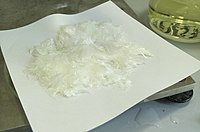
Photo from wikipedia
Crop response to phosphorous (P) application is often erratic in most soil types in the world. In alkaline calcareous soils, P retention and mobilization take place due to precipitation and… Click to show full abstract
Crop response to phosphorous (P) application is often erratic in most soil types in the world. In alkaline calcareous soils, P retention and mobilization take place due to precipitation and adsorption. P adsorption isotherms are the powerful tools for assessing optimum P levels for different crops and soils. Laboratory and field studies were carried out to evaluate P sorption capacity in a highly calcareous soil and corresponding fertilizer levels for yielding 0.1 to 1.0 mg P L−1 of soil solution. Although Freundlich adsorption isotherm model showed a better fit than Langmuir model, P fertilizer levels used in the field, ranging from 20 to 150 kg P2O5 ha−1, were based on Langmuir model to yield the estimated P solution. Moreover, nitrogen (N) and potassium (K) were applied at the rates of 120 and 60 kg ha−1 as urea and potassium sulfate (K2SO4), respectively, in a basal treatment at the time of sowing. Grains per spike, 1000-grain weight, grain yield, spike length, and biological yield were increased as the level of P increased, but the non-significant differences among 90, 100, and 120 kg P2O5 ha−1 for most of the above parameters suggested that the former rate could be the maximum level for wheat fertilization in the calcareous soil. Similarly, plant N, P, and K were increased with application of P, but non-significant differences were observed from doses 90 to 120 kg P2O5 ha−1. Moreover, the rate of 90 kg P2O5 ha−1 could yield 0.6 mg P L−1 of soil solution as per Langmuir adsorption isotherm model, while as per Freundlich model, this value could reach only 0.3–0.4 mg P L−1, which is close to the published literature. It is concluded that Freundlich adsorption isotherm is more suitable to be used for the calculation of phosphatic fertilizer rate and its adsorption capacity in the given soil than Langmuir adsorption isotherm.
Journal Title: Journal of Soil Science and Plant Nutrition
Year Published: 2020
Link to full text (if available)
Share on Social Media: Sign Up to like & get
recommendations!